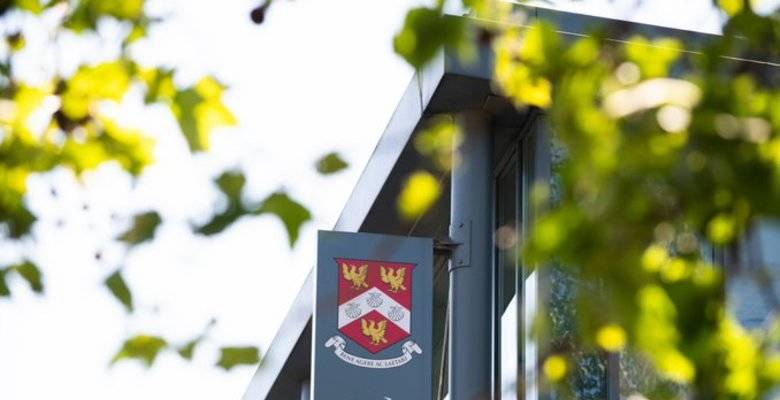
With over four and a half billion people now in some form of lockdown, the whole world has come to a standstill. Not because of war or famine; not because of global warming, a meteorite, earthquakes or floods. Instead, it’s all because of a tiny, invisible particle only a billionth the size of a single human cell. Something so small and simple that it makes a single bacterial cell look complicated. Technically, the virus doesn’t even count as a living organism; it doesn’t grow, it cannot move on its own, it requires no nutrition and it has no sense of its surroundings. But right now, despite all of our science, technology and medicine, we are largely defenceless against it. So, what on earth is going on? In this article, Head of Wellbeing and KGS Biology Teacher Nick Forsyth, shares his scientific opinion.
I think that it was a Chinese general who first said “Know thine enemy”. So what is it with this virus? It doesn’t consume us like bacteria might, it doesn’t steal our nutrients like a parasite would and it seems callously uncaring as to whether we live or die. So what does it actually want from us?
Well, of course, the virus doesn’t ‘want’ anything. It just does. And what it does is it makes copies of itself - unfortunately for us, very effectively.
All living organisms, indeed practically all living cells, contain genetic information or genes. Genes are simply sections of a remarkable molecule called DNA, remarkable in that it is able to make an exact copy of itself. It can literally replicate itself. This means that genes get passed down from one generation to the next so an acorn has all the genes it needs to grow into an oak tree, a tadpole has all the genes it needs to become a frog and a fertilized egg cell has all the genes necessary to become a human baby.
But genes cannot exist on their own. They need an organism to help them to do their copying. So in some ways the gene and the organism co-exist. The gene is the replicator and the organism is the vehicle that helps and allows the gene to copy itself. But it’s the gene that’s in charge. As the biologist Richard Dawkins famously put it, the gene is utterly and ruthlessly “selfish”, directing and controlling the organism to ensure that the gene passes down into the next generation and spreads through a particular population. Genes that are successful in doing this survive whilst genes that are less successful die out. This is how natural selection works.
So in the case of the coronavirus, its own miniscule piece of genetic material (in this case a similar molecule to DNA called RNA) wants to replicate itself – as often as possible. The actual virus, or organism if you like, is just a coat of protein molecules surrounding the genetic material that sets things up so that the genetic material can do its copying.
All viruses do this. Their protein coat attaches to a particular cell in a host organism. This could be in a plant, animal or human. Once the virus attaches, the genetic material passes into the cell and can then begin replicating itself. It does this by inserting its piece of genetic material into the cell’s own DNA copying machine so that when the cell reads its genetic instructions, it now makes a copy of the virus as well.
Imagine a photocopying machine copying a big pile of paper. The virus has slipped its own piece of paper into the pile so that it also gets copied by the machine – again and again and again. So now there are thousands of identical viruses in the cell. These then burst out and infect new cells or, even better for the virus, they can somehow jump into another individual and the whole process begins again.
So why doesn’t the virus go away and do its replicating somewhere else?
Well that’s exactly what it used to do. Until recently, this particular coronavirus was found in bats. But then the virus changed (or mutated) and began to infect another animal called a pangolin and from there it jumped into us. It’s not the first time that a virus has jumped from an animal population into humans but when it does it’s invariably bad news. The process is called zoonosis and it happened with HIV, the virus that causes AIDS, when a virus that previously only infected monkeys mutated and jumped into humans. It also happened with the Ebola virus that came from bats, swine flu that came from pigs and bird flu that came from birds. In each case the genetic information has changed or mutated so that the new virus is now able to get into human cells.
But jumping into the human population is just stage one for the virus. If it’s going to be really successful it also needs to be able to pass from human to human. Bird flu is a particularly dangerous virus that has made the jump from birds to humans. But what it cannot easily do is pass from human to human and this means that, so far, the only people that have become infected with bird flu are farmers and other people who work closely with domestic birds.
Viruses have been around for millions, if not billions, of years. Inevitably, some will be more successful than others in the way that they replicate and spread through a population. This is known as their transmission cycle. In the world of viruses there is one that’s a past master at doing this – the common cold.
Despite its lowly reputation, the cold virus is supremely successful at replicating and spreading in the human population; indeed the common cold is our most frequent disease and has been infecting humans all over the world for thousands of years. Yet we still have no cure or vaccine. One reason for this is that the cold virus can easily mutate. This means that there is a small change to the genetic material which makes the virus’s protein coat.
Just when we defeat one cold virus, another one comes along which is slightly different so now we have to start all over again building up our defences. There are around 200 different versions or strains of the cold virus and it’s impossible to develop a vaccine that will work on them all. Simply put, the cold virus isn’t just one step ahead of our immune system – it’s 200 steps ahead.
But there are other reasons why the cold virus is so successful. Like its cousin, the coronavirus, it’s very easily spread from one person to another. You can also spread it even though you are not showing any symptoms – you are asymptomatic. This means that you have the virus inside you and you can spread it without knowing.
But another crucial factor is that the common cold virus doesn’t kill anyone. Sure, getting a cold is annoying but nobody really dies from a cold and so we simply put up with it, allowing the virus to go on doing its replicating and spreading, generation after generation.
Of course the coronavirus is different. It does kill people – lots of them. But this will be its undoing. Unlike the common cold virus we cannot accept its terms and so, right now, scientists around the world are working out a way to defeat it.
As we know it’s not only the new coronavirus that can kill people. Plenty of other viruses can do that and indeed many of these are far more lethal. If you get infected with the Rabies virus for instance, without treatment you will be dead within a matter of days. Without drugs, the HIV virus that causes AIDS will also, most likely, kill anyone who gets it and we know from the epidemic in 2014 that the Ebola virus kills about half of all the people who get infected with it, substantially more than the coronavirus.
So if other viruses are more dangerous that the coronavirus, what is so special about Covid-19? Why has it brought the world to its knees when these other viruses have not?
Well, it’s all about the transmission cycle – how easily the virus spreads from one person to another.
SARS (Severe Acute Respiratory Syndrome) was a very serious epidemic that appeared in China in 2003 but it had a much lower rate of transmission than its cousin, the coronavirus, so it never became a pandemic in the way that Covid-19 has. It’s true that SARS was much more lethal than coronavirus but this was actually ‘helpful’ in terms of transmission because many patients with SARS simply died before they could transmit the virus to other people. It was also the case with SARS that someone only really became contagious once they became seriously ill.
In the case of HIV, the virus is really only spread through sexual contact. So if you get on a crowded bus and ten people are infected with HIV, then you have zero chance of catching it from them. But if you get on a bus and ten people have Covid-19, even if they don’t know it, you will have a pretty good chance of catching it together with most other people on the bus.
Ebola is extremely dangerous but you have to be in very close contact with someone to get it. As one scientist put it, you could be on that bus again and even sitting next to someone with Ebola but as long as they were not vomiting on you then you would probably be OK. Also, like SARS, you can only spread the Ebola virus once you are showing symptoms and if you have symptoms of Ebola then you will not be in any fit state to walk to the next village or town or go to a football match or jump on a plane and fly to another continent.
Contrast this with the common cold virus or coronavirus or HIV. If you met someone in the street they could be infected and could pass it on without even knowing it. But because they are not showing any symptoms you would be happy to shake hands with them, or hug them or even have sex with them.
So the coronavirus is really the perfect storm of all these different factors. Because it’s spread through the air and even surfaces, it’s extremely contagious. It’s also hard to protect yourself against it unlike say, HIV. Anyone can spread it even if they don’t have any symptoms and while it can kill a lot of people this does not happen so often and so quickly that it slows down the transmission of the virus.
But there is one other crucial factor that means that we are all particularly vulnerable and that is that nobody in the population, anywhere in the world, has got any prior protection to the new coronavirus. To understand why this is we have to talk about special protein molecules called antibodies and antigens.
Antibodies and antigens
Remember how all viruses have a coat of protein molecules surrounding their genetic material? Some of these proteins allow the virus to lock onto its host cell and invade it but they can also act as antigens which means that they trigger an immune response by your body. Antigens are highly specific which is why viruses can only get into certain cells. But if the virus mutates and the genetic material changes, then the antigen will now be slightly different.
Your body’s immune system consists of white blood cells, some of which produce special protein molecules called antibodies. Antibodies attach to the virus antigen and deactivate it, such as by stopping it from being able to lock onto a host cell. So antibodies are great. In fact, the only thing that will save you if you get a viral infection are antibodies.
But antibodies, like antigens, are highly specific. You need to produce a different one for each particular antigen out there and this takes time. Like other infectious diseases, if you do get the coronavirus, you will probably be unwell for a week or so while your body gears up to make the correct antibody. Once you’ve made enough antibody you can begin to destroy the virus. The even better news is that because you now have the correct antibody in your blood you should be immune to any further infection. Right now, scientists are unsure how long this immunity might last.
But what happens if the virus mutates? Well, now the virus has a different antigen and so your body has to go back to the drawing board to produce a whole new antibody. This is what happens with the cold virus and also with seasonal flu in a process known as antigen drift. Each year the flu virus changes its antigen slightly. This means that each year the scientists have to come up with a new vaccine for that particular strain of seasonal flu but because it’s a relatively small change it’s fairly easy to do. Over the years the population is exposed to many different types of viral antigen and so we have all built up a healthy supply of different antibodies.
But if there is a more dramatic mutation, something known as antigen shift, we now see a very different antigen system on the new virus. Because it’s new and quite different, nobody in the population has any of the corresponding antibody and so until we can build it up we are all pretty much helpless and vulnerable.
Mutations happen in all organisms but they are relatively rare and take time to have an effect. If I have a mutation that could be passed onto my children or even my grandchildren, it’s obviously going to be many years before we see the result. But the virus is replicating so quickly that mutations are happening all the time. Imagine that photocopy machine again. If it’s copying the same piece of paper 24/7 it’s inevitable that mistakes will occur more frequently. Most mutations will not make any difference or will even be harmful to the virus but, simply by chance, some will allow the virus to get better at replicating, spreading or avoiding detection by our immune systems.
The new coronavirus is a type of virus called a retrovirus that means that its genetic material is RNA rather than DNA. Because RNA is a more unstable molecule that DNA, mutations are generally more common in retroviruses such as the common cold and the flu but already scientists think that the new coronavirus is relatively stable which is good news.
So what can we do about coronavirus? How is all this going to end?
Well, this will probably depend on a number of different factors rather than a single magic bullet cure but all of them involve breaking the transmission cycle of the virus. The first and simplest thing we can do is to reduce the transmission by staying at home and social distancing and all of us must play our part in this.
Even with lockdown, though, lots of people will still get the virus. But remember, for all the scary numbers, the vast majority of people who get the virus will experience only mild symptoms or will not even know that they have had it. Over time, as more antibodies build up in the population, we should all begin to benefit from what is called herd immunity.
In the same way that animals that herd together are safer from predators, herd immunity simply means that the more of us that become immune to the virus, the safer we all are. Imagine a class of say, twenty students. If a new student comes into the class and is infected with the virus, they could pass it on to a large number of the students. Each of these will now move through the school infecting other students. But if ninety per cent of the students are immune, there is now a much smaller chance that the virus will pass into the two unprotected students who will then carry it out of the classroom.
Herd immunity is a powerful defence against the coronavirus but it will take time to build up. There is a way that we can speed things up and that’s by using a vaccine.
So how does a vaccine work?
Vaccines are fantastic. Since the first vaccination by Edward Jenner in 1796, vaccines have prevented millions of deaths and when one against the coronavirus becomes available, countless more lives will undoubtedly be saved.
In recent years we’ve heard a lot about the ‘anti-vax’ movement. This is a ludicrous and dangerous piece of fake news, right up there with the idea that coronavirus is somehow linked to the 5G network. Far and away, our best hope right now is a vaccine against coronavirus so just how will it work?
A viral vaccine involves introducing a harmless piece of a particular virus into someone. The vaccine cannot make the person sick but their immune system will still recognise the viral antigen and will then begin the process of manufacturing the correct antibody. If the person later becomes infected with the real virus, they already have the all-important antibodies that will destroy the virus before it can begin its job of replicating.
Because the coronavirus is new, it will take some time to make the vaccine and it might not be ready until next year. But even then it might not be a panacea. This will depend not only on how effective it is, but also on how easy it will be to manufacture and distribute all over the world.
One of the most successful vaccination programmes of all time was against smallpox. Smallpox was a terrifying disease that killed hundreds of millions of people around the world but there were a number of factors that helped to defeat it. Even though the virus was highly contagious, it could only be spread once symptoms appeared. The symptoms were also very obvious and this meant that it was easy to quickly isolate people who had the disease, reducing transmission. The virus was also very stable. It didn’t mutate and this meant that once the vaccine was made it was extremely effective, producing a strong immune response in almost everyone.
The vaccine itself was also very stable. It didn’t need refrigeration, for instance, and this made it much easier to transport around the world. It was also very easy to manufacture and administer and it didn’t need anyone with medical training to do it. This meant that a vaccination kit could arrive in even the remotest village, brought there by car or bicycle or even on foot. All someone in the village needed to do was boil some water to activate the vaccine and sterilize a special two-pronged needle. This was then dipped into the prepared vaccine and used to pierce the skin of each person being vaccinated.
It was all incredibly simple and highly effective and smallpox was wiped out. We must all hope that any coronavirus vaccine will work equally well.
Anti-Viral drugs
Anti-viral drugs are another was to disrupt the transmission cycle of the virus and can be very effective. Close to forty million people around the world are infected with HIV and there is no vaccine. But if someone with HIV is receiving anti-viral treatment then their chance of dying from the disease is extremely low and they can’t pass it on to anyone else.
Anti-virals work in different ways. Some of them, such as a promising drug called Remdesivir, work on the virus’s genetic material, stopping it from replicating. Others work on the virus’s protein coat, for instance by attaching to the coronavirus spikes, the red blobs that you see on pictures of the virus. When these drugs attach to the spike, it is hoped that this will block the virus’s docking site and the virus will not be able to get inside our cells and replicate.
Testing
Another vital component in our fight against the virus is testing. The more we test, the more accurate the data that tells us how quickly the virus is spreading.
Right now there are two tests and they are quite different. The first test is called PCR and this determines if you are infected with the virus. PCR stands for Polymerase Chain Reaction and is a technique that is used to amplify genetic material. So let’s say you take a sample from someone who has the virus. The sample will contain a tiny amount of the virus’s genetic material (RNA). The PCR technique allows the genetic material to replicate so now you have double the amount. Then it doubles again and then again until you now have a much larger quantity of RNA that can be tested. PCR is very accurate and is used a lot in forensic science to detect tiny amounts of DNA that might be left at a crime scene but the problem is that it takes time to do it.
The second test is a test for actual antibodies that will only be there in someone’s blood a week or so after the initial infection. The test is particularly useful because it identifies people who have been exposed to the virus and who are now, in theory at least, immune. This means that they can return to work with no fear of catching the virus again or passing it on to anyone else. The test is very quick but there are concerns around the reliability.
So in our armoury we now have social distancing, herd immunity, vaccination, anti-virals, testing and several other techniques such as mobile phone apps that may help with contact tracing. All of these weapons will help us gain the upper hand against the virus. It is simply a matter of time.
The coronavirus has already inflicted a terrible toll around the world but it is no match for human ingenuity, resolve and organisation. With a common social and moral purpose, it will be defeated. But for now we must all continue to play our part in helping to break the transmission cycle. Remember, the virus cannot get into your home by itself - someone has to bring it in. So please continue to keep yourself and others safe. Stay at home, observe social distancing and keep washing those hands.
Nick Forsyth
Head of Wellbeing
Kingston Grammar School
April 2020
.png&command_2=resize&height_2=85)














